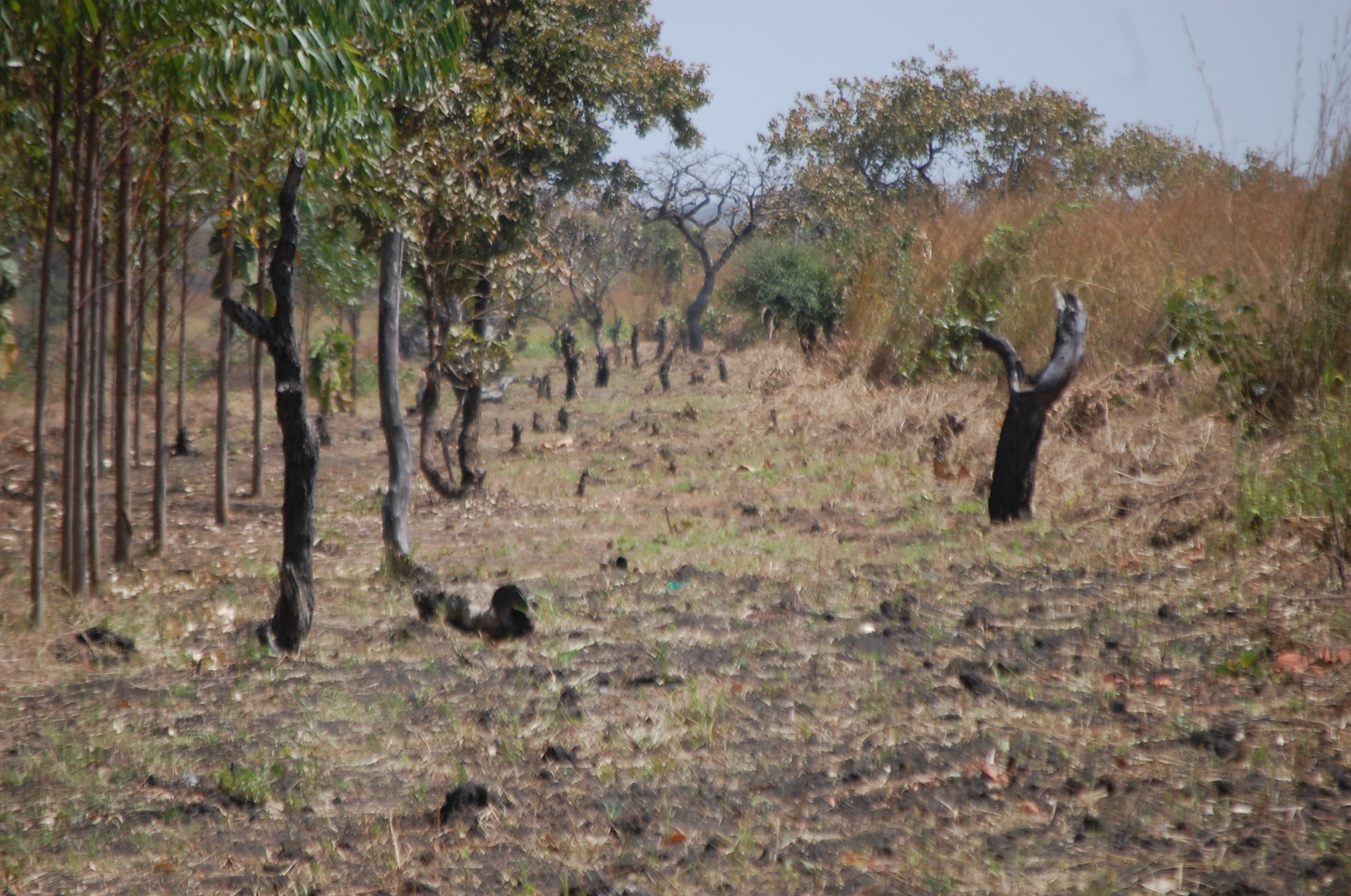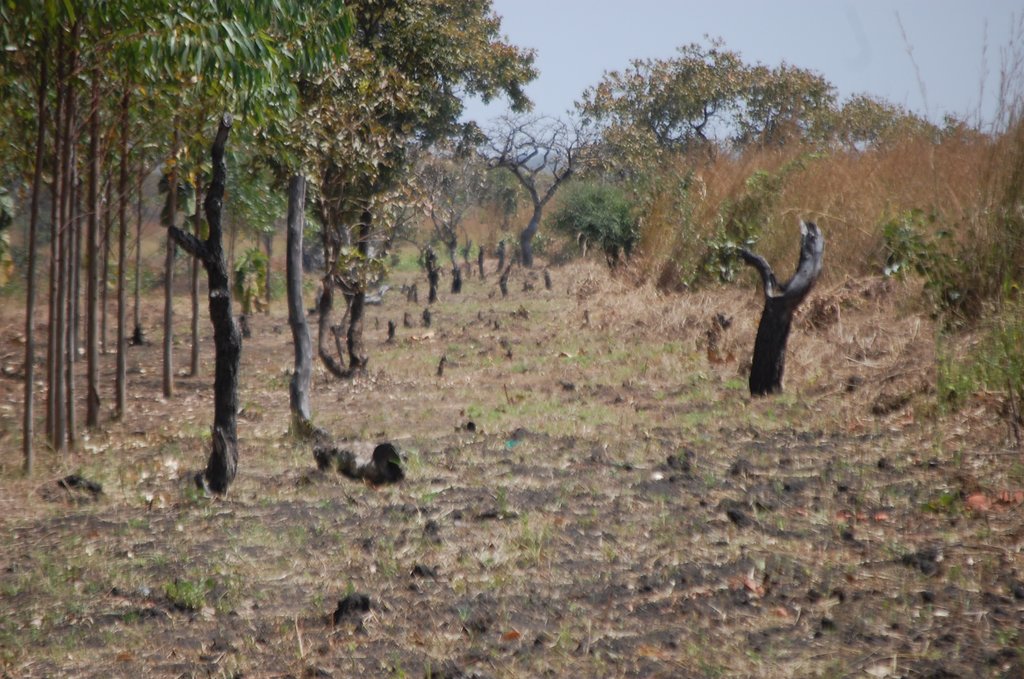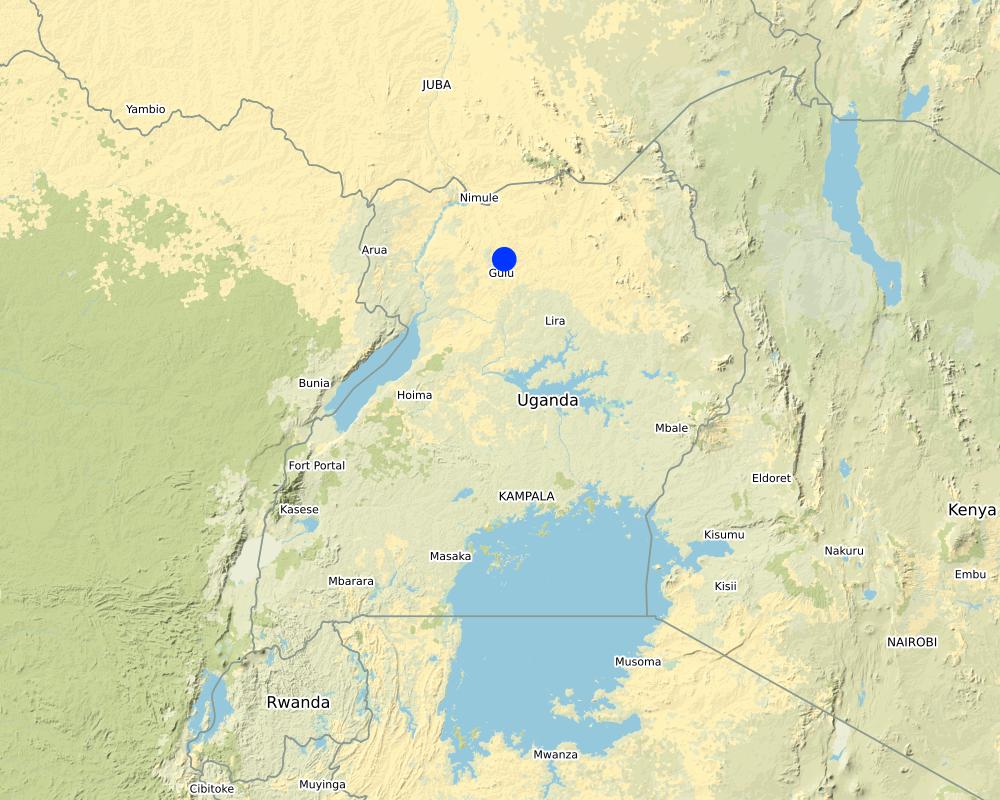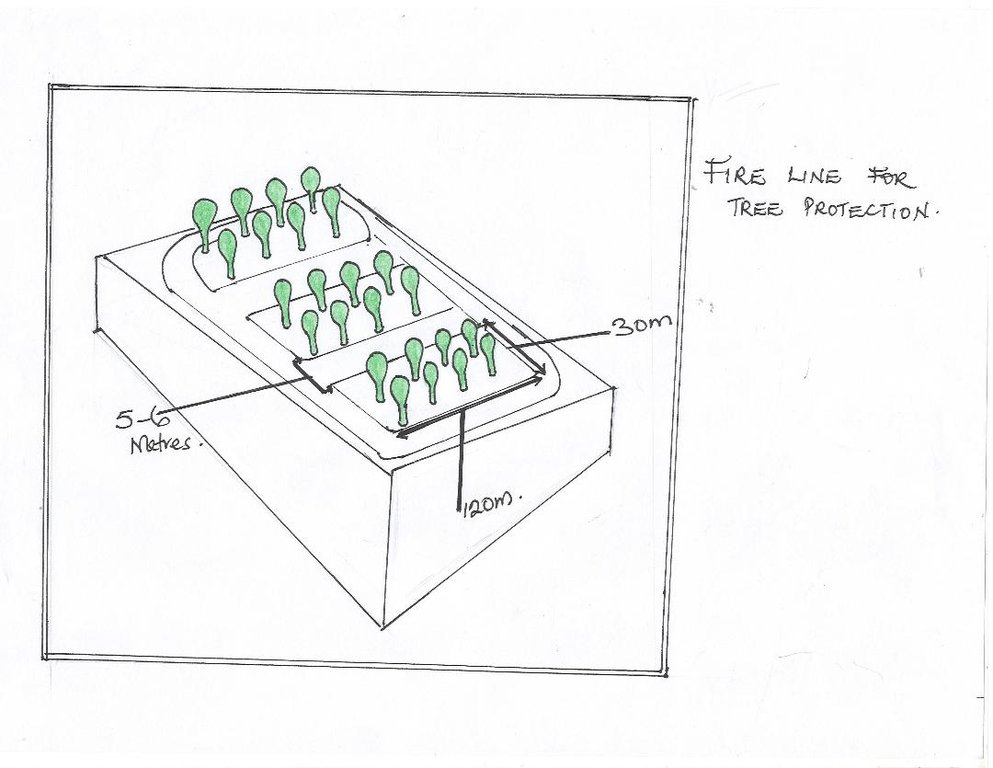Firelines For Tree Protection [乌干达]
- 创建:
- 更新:
- 编制者: Kamugisha Rick Nelson
- 编辑者: JOY TUKAHIRWA, Bernard Fungo
- 审查者: John Stephen Tenywa, Nicole Harari, Udo Höggel
Koyo
technologies_2149 - 乌干达
查看章节
全部展开 全部收起1. 一般信息
1.2 参与该技术评估和文件编制的资源人员和机构的联系方式
关键资源人
SLM专业人员:
Anywar Michael
070485161
Gulu tree farmers association
Gulu District
乌干达
有助于对技术进行记录/评估的项目名称(如相关)
Scaling-up SLM practices by smallholder farmers (IFAD)有助于对技术进行记录/评估的机构名称(如相关)
Uganda Landcare Network (ULN) - 乌干达1.3 关于使用通过WOCAT记录的数据的条件
(现场)数据是什么时候汇编的?:
27/4/2017
编制者和关键资源人员接受有关使用通过WOCAT记录数据的条件。:
是
1.4 所述技术的可持续性声明
这里所描述的技术在土地退化方面是否存在问题,导致无法被认为是一种可持续的土地管理技术?:
否
注释:
The technology is established during the dry season to guard against spread of fire within a tree or garden plantation for environmental conservation
2. SLM技术的说明
2.1 技术简介
技术定义:
Fire lines are established at the boundary between tree plantations to guard against wild forest fires that destroy the valuable tree species
2.2 技术的详细说明
说明:
Firelines, also known as firebreaks, are vegetation-free spaces, established within or between tree plantations. They also often serve as roads for motorised transport used to collect forest produce such as firewood and timber. The primary aim of this technology is to prevent wild fires from attacking and destroying trees, especially during the dry seasons. In northern Uganda, the technology is based on firelines of 5-6 meters width. Planted forests that use this technology in northern Uganda have an average size of 30 m by 120 m.
The establishment of this technology requires professional advice, starting with demarcation, using ropes or strings, and tools such as hand hoes, machetes and slashers. Maintenance of fire lines involves monitoring to ensure that the spaces are free of vegetation and dead wood. Sometimes, big trees with large canopies are maintained to discourage vegetation undergrowth's and accumulation of dead materials on forest floors.
The benefits derived from this SLM technology are both short and long term, including protection of valuable tree species from being affected by the fire, reduction of impact of air pollution and promotion of ecological balance. When professionally done, the value of these products can significantly offset the cost of maintaining the firebreaks in a given forest setting, especially where such fires become common. It is important to note that fire lines alone may not be a measure to prevent fire outbreaks. There could be need for community bylaws and fire fighting facilities to supplement this effort.
2.3 技术照片
2.4 技术视频
注释、简短说明:
Video link for fire line for tree protection in Gulu District
日期:
10/12/2017
位置:
Gulu District, Northern Uganda
摄影师的名字:
Issa Aiga
2.5 已应用该技术的、本评估所涵盖的国家/地区/地点
国家:
乌干达
区域/州/省:
Northern Region,Uganda
有关地点的进一步说明:
Gulu Municipality, Gulu District
注释:
Map showing technology site in Northern Uganda
Map
×2.6 实施日期
注明实施年份:
2011
2.7 技术介绍
详细说明该技术是如何引入的:
- 通过土地使用者的创新
- 通过项目/外部干预
注释(项目类型等):
Supported by National Advisory Services (NAADS)
3. SLM技术的分类
3.1 该技术的主要目的
- 减少、预防、恢复土地退化
- 保持/提高生物多样性
- 创造有益的经济影响
3.2 应用该技术的当前土地利用类型

混合(作物/放牧/树木),包括农林
- 农林业
主要产品/服务:
Trees with rice and bananas
如果由于技术的实施而导致土地用途发生变化,则在技术实施前说明土地利的用途。:
Cropland
3.3 有关土地利用的更多信息
该技术所应用土地的供水:
- 雨养
注释:
Rely on rainfed and in case of low or unreliable rainfalls the land users face water shortage
每年的生长季节数:
- 2
具体说明:
April-August and August-November
3.4 该技术所属的SLM组
- 森林种植管理
- Protection against fires
3.5 技术传播
具体说明该技术的分布:
- 均匀地分布在一个区域
如果该技术均匀地分布在一个区域上,请注明覆盖的大致区域。:
- < 0.1 平方千米(10 公顷)
3.6 包含该技术的可持续土地管理措施

植物措施
- V3:植被的清理

管理措施
- M2:改变管理/强度级别
- M3:根据自然和人文环境进行布局
3.7 该技术强调的主要土地退化类型

生物性退化
- Bc:植被覆盖的减少
- Bf:火灾的有害影响
3.8 防止、减少或恢复土地退化
具体数量名该技术与土地退化有关的目标:
- 防止土地退化
- 减少土地退化
4. 技术规范、实施活动、投入和成本
4.1 该技术的技术图纸
4.2 技术规范/技术图纸说明
The technical drawing of the fireline system contains a set of firelines between the forest patches. Firelines are typically 5-6 metres wide.
The plantations (forest patches) shown in the technical drawing have a dimension of 30 X 120 metres.
4.3 有关投入和成本计算的一般信息
具体说明成本和投入是如何计算的:
- 每个技术单元
指定单位:
Fireline
指定体积、长度等(如果相关):
5-6 metres wide and as long as the forest length
其它/国家货币(具体说明):
Ugandan Shilling
注明美元与当地货币的汇率(如相关):1美元=:
3400.0
注明雇用劳工的每日平均工资成本:
5000
4.4 技术建立活动
| 活动 | 措施类型 | 时间 | |
|---|---|---|---|
| 1. | Identify a tree plantation | 管理 | Before establishment, rainy season |
| 2. | Buying equipment | 管理 | Before establishment |
| 3. | Mark the fire line | 管理 | Before establishment, during the rainynseason |
| 4. | Clear the vegetation | 结构性的 | During establishment, during the rainy season |
| 5. | Monitoring | 管理 | After establishment, during the dry season |
4.5 技术建立所需要的费用和投入
| 对投入进行具体说明 | 单位 | 数量 | 单位成本 | 每项投入的总成本 | 土地使用者承担的成本% | |
|---|---|---|---|---|---|---|
| 劳动力 | Persons days (fireline of 5-6 meters width) | persons | 3.0 | 5000.0 | 15000.0 | 100.0 |
| 设备 | Hoe | Pieces | 1.0 | 10000.0 | 10000.0 | 100.0 |
| 设备 | Panga | Pieces | 2.0 | 5000.0 | 10000.0 | 100.0 |
| 设备 | Tape measure | Pieces | 1.0 | 30000.0 | 30000.0 | 100.0 |
| 设备 | Rope | roll | 2.0 | 2500.0 | 5000.0 | 100.0 |
| 技术建立所需总成本 | 70000.0 | |||||
注释:
The farmer had kept very well all the the records on the costs which helped us to calculate the costs
4.6 维护/经常性活动
| 活动 | 措施类型 | 时间/频率 | |
|---|---|---|---|
| 1. | Monitoring | 管理 | Twice a year, during the dry seasons |
| 2. | Cutting the vegetation | 管理 | Once a year before the dry season |
4.7 维护/经常性活动所需要的费用和投入(每年)
| 对投入进行具体说明 | 单位 | 数量 | 单位成本 | 每项投入的总成本 | 土地使用者承担的成本% | |
|---|---|---|---|---|---|---|
| 劳动力 | Labour for slashing | Persons | 2.0 | 10000.0 | 20000.0 | 100.0 |
| 技术维护所需总成本 | 20000.0 | |||||
注释:
The technology requires low cost inputs for establishing and maintenance with regard to paying for clearing vegetation. However, labour is not readily available.
4.8 影响成本的最重要因素
描述影响成本的最决定性因素:
Labour is not readily available, and is thus expensive. Hence it accounts for most of the costs required for establishment.
5. 自然和人文环境
5.1 气候
年降雨量
- < 250毫米
- 251-500毫米
- 501-750毫米
- 751-1,000毫米
- 1,001-1,500毫米
- 1,501-2,000毫米
- 2,001-3,000毫米
- 3,001-4,000毫米
- > 4,000毫米
指定年平均降雨量(若已知),单位为mm:
1350.00
农业气候带
- 潮湿的
5.2 地形
平均坡度:
- 水平(0-2%)
- 缓降(3-5%)
- 平缓(6-10%)
- 滚坡(11-15%)
- 崎岖(16-30%)
- 陡峭(31-60%)
- 非常陡峭(>60%)
地形:
- 高原/平原
- 山脊
- 山坡
- 山地斜坡
- 麓坡
- 谷底
垂直分布带:
- 0-100 m a.s.l.
- 101-500 m a.s.l.
- 501-1,000 m a.s.l.
- 1,001-1,500 m a.s.l.
- 1,501-2,000 m a.s.l.
- 2,001-2,500 m a.s.l.
- 2,501-3,000 m a.s.l.
- 3,001-4,000 m a.s.l.
- > 4,000 m a.s.l.
说明该技术是否专门应用于:
- 不相关
5.3 土壤
平均土层深度:
- 非常浅(0-20厘米)
- 浅(21-50厘米)
- 中等深度(51-80厘米)
- 深(81-120厘米)
- 非常深(> 120厘米)
土壤质地(表土):
- 中粒(壤土、粉土)
土壤质地(地表以下> 20厘米):
- 中粒(壤土、粉土)
表土有机质:
- 中(1-3%)
5.4 水资源可用性和质量
地下水位表:
5-50米
地表水的可用性:
好
水质(未处理):
不良饮用水(需要处理)
水的盐度有问题吗?:
否
该区域正在发生洪水吗?:
否
5.5 生物多样性
物种多样性:
- 中等
栖息地多样性:
- 中等
5.6 应用该技术的土地使用者的特征
定栖或游牧:
- 定栖的
生产系统的市场定位:
- 混合(生计/商业
非农收入:
- 低于全部收入的10%
相对财富水平:
- 非常贫瘠
个人或集体:
- 个人/家庭
- 团体/社区
机械化水平:
- 手工作业
性别:
- 男人
土地使用者的年龄:
- 青年人
- 中年人
5.7 应用该技术的土地使用者拥有或租用的平均土地面积
- < 0.5 公顷
- 0.5-1 公顷
- 1-2 公顷
- 2-5公顷
- 5-15公顷
- 15-50公顷
- 50-100公顷
- 100-500公顷
- 500-1,000公顷
- 1,000-10,000公顷
- > 10,000公顷
这被认为是小规模、中规模还是大规模的(参照当地实际情况)?:
- 小规模的
5.8 土地所有权、土地使用权和水使用权
土地所有权:
- 社区/村庄
- 个人,未命名
土地使用权:
- 自由进入(无组织)
- 个人
注释:
No community bylaws and the land is free. If you are a member of the community or household you are supposed to use the land and, thereafter leave it for others to use in future.
5.9 进入服务和基础设施的通道
健康:
- 贫瘠
- 适度的
- 好
教育:
- 贫瘠
- 适度的
- 好
技术援助:
- 贫瘠
- 适度的
- 好
就业(例如非农):
- 贫瘠
- 适度的
- 好
市场:
- 贫瘠
- 适度的
- 好
能源:
- 贫瘠
- 适度的
- 好
道路和交通:
- 贫瘠
- 适度的
- 好
饮用水和卫生设施:
- 贫瘠
- 适度的
- 好
金融服务:
- 贫瘠
- 适度的
- 好
6. 影响和结论性说明
6.1 该技术的现场影响
社会经济效应
生产
生产故障风险
注释/具体说明:
Presence of firelines
土地管理
注释/具体说明:
Control of bush fires
收入和成本
农业投入费用
注释/具体说明:
Purchase of pangas and ropes for mesuring
工作量
注释/具体说明:
Cutting and clearing the vegetation
社会文化影响
SLM/土地退化知识
注释/具体说明:
KNowledge on how to establish a trench having the right spacing
生态影响
土壤
土壤水分
土壤覆盖层
土壤有机物/地下C
生物多样性:植被、动物
植被覆盖
注释/具体说明:
Vegetation cut to create firelines
6.2 该技术的场外影响已经显现
对邻近农田的破坏
注释/具体说明:
Presence of firelines
6.3 技术对渐变气候以及与气候相关的极端情况/灾害的暴露和敏感性(土地使用者认为的极端情况/灾害)
渐变气候
渐变气候
| 季节 | 气候变化/极端天气的类型 | 该技术是如何应对的? | |
|---|---|---|---|
| 年温度 | 增加 | 好 | |
| 季节性温度 | 湿季/雨季 | 减少 | 适度 |
气候有关的极端情况(灾害)
气候灾害
| 该技术是如何应对的? | |
|---|---|
| 森林火灾 | 适度 |
| 陆地火灾 | 非常好 |
注释:
Wild fires are a common threat
6.4 成本效益分析
技术收益与技术建立成本相比如何(从土地使用者的角度看)?
短期回报:
积极
长期回报:
积极
技术收益与技术维护成本/经常性成本相比如何(从土地使用者的角度看)?
短期回报:
积极
长期回报:
积极
注释:
The technology is positive with regards to maintenance costs which are rather low after establishment
6.5 技术采用
- 1-10%
如若可行,进行量化(住户数量和/或覆盖面积):
5
在所有采用这项技术的人当中,有多少人是自发地采用该技术,即未获得任何物质奖励/付款?:
- 0-10%
注释:
Very few have adopted the technology because it demands a lot of labour and most people have not taken an initiative to start on their own
6.6 适应
最近是否对该技术进行了修改以适应不断变化的条件?:
是
若是,说明它适应了哪些变化的条件:
- 气候变化/极端气候
具体说明技术的适应性(设计、材料/品种等):
The cut vegetation is carried away to other fields or left in the place where its cut for decomposition
6.7 该技术的优点/长处/机会
| 土地使用者眼中的长处/优势/机会 |
|---|
| Low costs of establishment and maintance |
| Can easily be replicated in other areas where fires are common |
| Cut vegetation can be taken to other areas as mulch or be left to decompose for soil fertility improvement |
| 编制者或其他关键资源人员认为的长处/优势/机会 |
|---|
| Does not require high sophisticated skills which are available with the extension agent |
| Very good at preventing bush fires |
6.8 技术的弱点/缺点/风险及其克服方法
| 土地使用者认为的弱点/缺点/风险 | 如何克服它们? |
|---|---|
| Requires money which may not be readily available with the farmer to hire labour | Work in groups and form an association between tree planters to exchange labour |
| 编制者或其他关键资源人员认为的弱点/缺点/风险 | 如何克服它们? |
|---|---|
| Fire line alone may not be a measure alone to prevent fire outbreaks. There is a need for the formulation and application of community bylaws on fires. | Support communities to formulate and implement bylaws on fires |
7. 参考和链接
7.1 信息的方法/来源
- 实地考察、实地调查
01
- 与土地使用者的访谈
01
- 与SLM专业人员/专家的访谈
- 根据报告和其他现有文档进行编译
- Compiler
Rick Kamugisha
链接和模块
全部展开 全部收起链接
无链接
模块
无模块





